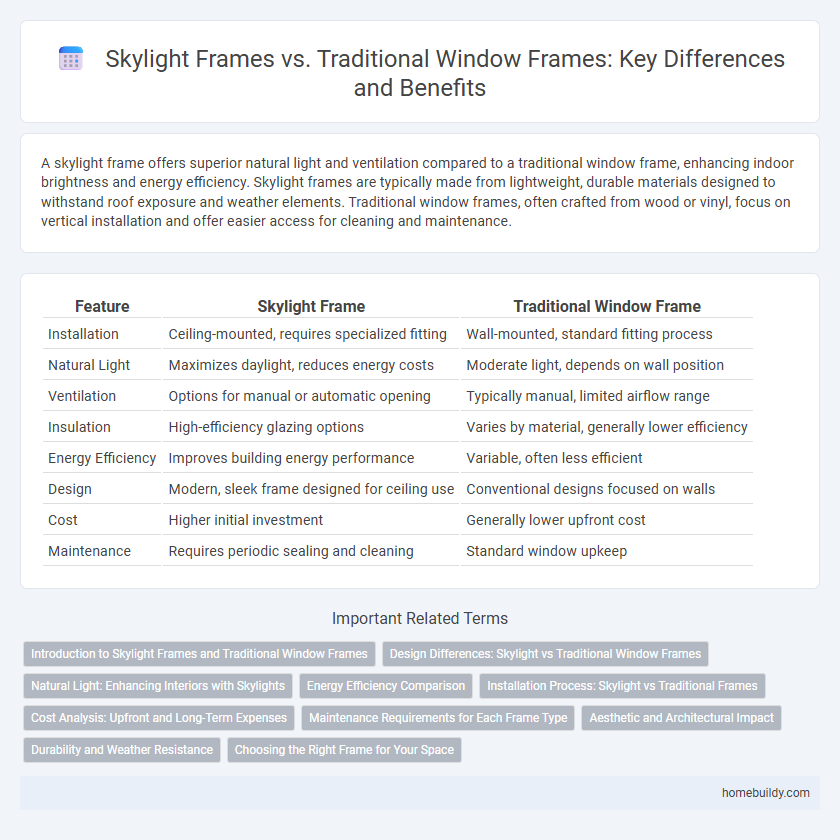A skylight frame offers superior natural light and ventilation compared to a traditional window frame, enhancing indoor brightness and energy efficiency. Skylight frames are typically made from lightweight, durable materials designed to withstand roof exposure and weather elements. Traditional window frames, often crafted from wood or vinyl, focus on vertical installation and offer easier access for cleaning and maintenance.
Table of Comparison
| Feature | Skylight Frame | Traditional Window Frame |
|---|---|---|
| Installation | Ceiling-mounted, requires specialized fitting | Wall-mounted, standard fitting process |
| Natural Light | Maximizes daylight, reduces energy costs | Moderate light, depends on wall position |
| Ventilation | Options for manual or automatic opening | Typically manual, limited airflow range |
| Insulation | High-efficiency glazing options | Varies by material, generally lower efficiency |
| Energy Efficiency | Improves building energy performance | Variable, often less efficient |
| Design | Modern, sleek frame designed for ceiling use | Conventional designs focused on walls |
| Cost | Higher initial investment | Generally lower upfront cost |
| Maintenance | Requires periodic sealing and cleaning | Standard window upkeep |
Introduction to Skylight Frames and Traditional Window Frames
Skylight frames are designed to maximize natural light by being installed on roofs, offering enhanced energy efficiency and a modern aesthetic compared to traditional window frames. Traditional window frames, typically made from wood, vinyl, or aluminum, are installed vertically on walls and focus on ventilation and exterior views. The choice between skylight and traditional window frames depends on architectural design, functionality needs, and lighting preferences.
Design Differences: Skylight vs Traditional Window Frames
Skylight frames differ from traditional window frames primarily in their orientation and structural design, as they are installed on roofs rather than vertical walls, requiring enhanced waterproofing and load-bearing capabilities. Unlike traditional frames that often use thicker, bulkier materials for wall integration, skylight frames utilize specialized materials like aluminum or uPVC to balance durability with lightweight construction. The design of skylight frames prioritizes maximizing natural light penetration and energy efficiency through double or triple glazing options, while traditional window frames focus more on ventilation and aesthetic integration with exterior facades.
Natural Light: Enhancing Interiors with Skylights
Skylight frames maximize natural light infiltration, creating brighter, more vibrant interiors compared to traditional window frames that primarily allow light from vertical angles. Positioned on the roof, skylight frames effectively capture daylight throughout the day, reducing the need for artificial lighting and improving energy efficiency. This enhanced natural illumination promotes healthier living spaces by connecting indoor environments with outdoor conditions.
Energy Efficiency Comparison
Skylight frames often outperform traditional window frames in energy efficiency due to advanced insulation materials like thermally broken aluminum or uPVC that reduce heat transfer. Their design minimizes air leakage and improves thermal performance, contributing to lower heating and cooling costs. Energy Star-rated skylight frames provide superior UV protection and better greenhouse gas reduction compared to conventional wood or aluminum window frames.
Installation Process: Skylight vs Traditional Frames
Skylight frames require precise roof cutting and waterproofing to ensure leak prevention, making their installation more complex than traditional window frames typically fitted within wall openings. The skylight installation process often demands professional expertise and specialized tools to handle the angled placement and sealing against weather elements effectively. Traditional window frame installation is generally quicker and less labor-intensive, as it involves straightforward fitting into pre-framed wall sections without extensive roofing modifications.
Cost Analysis: Upfront and Long-Term Expenses
Skylight frames often involve higher upfront costs compared to traditional window frames due to specialized materials and installation requirements. Long-term expenses can vary, with skylight frames potentially increasing energy costs if not properly insulated, while traditional frames generally offer more consistent energy efficiency. Maintenance and potential repair costs for skylights may also be higher due to exposure to weather and accessibility challenges.
Maintenance Requirements for Each Frame Type
Skylight frames typically require less frequent maintenance than traditional window frames due to their elevated positioning and use of durable materials like aluminum or fiberglass that resist weathering and corrosion. Traditional window frames, often made of wood or vinyl, demand regular upkeep including repainting, sealing, and occasional repairs to prevent rot, warping, or draft issues. Proper maintenance for skylight frames mainly involves routine cleaning and inspection for leaks, which enhances energy efficiency and longevity compared to the more intensive care needed for traditional frames.
Aesthetic and Architectural Impact
Skylight frames create a sleek, modern aesthetic that enhances natural light flow and adds architectural sophistication compared to traditional window frames. Their minimalistic design blends seamlessly with ceilings, offering unobstructed sky views that elevate interior ambiance and spatial perception. Unlike bulky traditional frames, skylight frames optimize visual openness and complement contemporary architectural styles with clean lines and innovative structural integration.
Durability and Weather Resistance
Skylight frames typically feature materials such as aluminum or reinforced fiberglass, which offer superior durability and resistance to weather compared to traditional wooden window frames prone to rot and warping. These advanced materials withstand extreme temperatures, UV exposure, and moisture, ensuring long-lasting performance and minimal maintenance. Enhanced seals and double or triple glazing in skylight frames further improve insulation and prevent water infiltration, outperforming conventional window frames in weather resilience.
Choosing the Right Frame for Your Space
Skylight frames offer superior natural light diffusion and thermal insulation compared to traditional window frames, enhancing energy efficiency and comfort in your space. Materials like aluminum or uPVC used in skylight frames provide durability and minimal maintenance, making them ideal for modern architectural designs. Selecting the right frame depends on factors such as roof slope, climate conditions, and aesthetic preferences to maximize functionality and style.
Skylight frame vs traditional window frame Infographic

 homebuildy.com
homebuildy.com